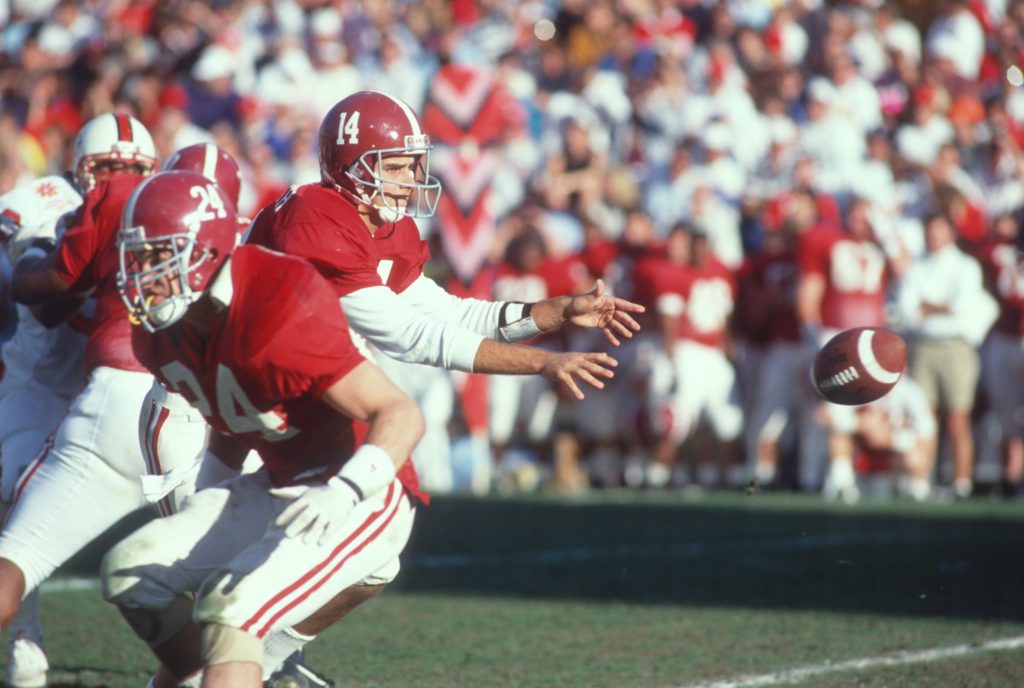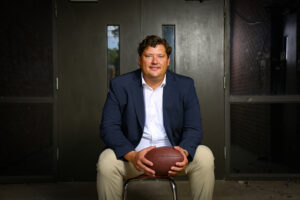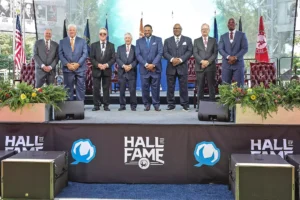The nightmare came, arriving like a formless grey mass.
It was a game most Alabama fans choose not to review. Those old enough to remember the 34-7 trouncing by Louisville on January 1, 1991 in the SunKist Fiesta Bowl have chosen to banish this memory into the dark caverns of their mind. Suffice it to say that highlights of this ungallant performance by Alabama fail to make the cut for the Jumbotron montage played year-by-year at Bryant-Denny Stadium.
Before the game, newspapermen went about the business of constructing their usual enticements, as the storylines turned to historical significance. Nick Saban has all but sated Alabama fans appetite for winning, but there was a time, many years ago, when the current state Alabama was as unsettling as a mysterious number on Caller ID. By 1991, almost eight years had passed since Bear Bryant’s death, but Alabama was still navigating the choppy waters of a crimson sea without its long-beloved captain. Yet Bryant’s memory continued to arrive in a low rumble. On its third coach since the messianic-like leader went to glory, the Crimson Tide had yet to find a suitable replacement—one who could bring home a national championship and establish the kind of consistent success that would meet the amplified benchmarks of fans. Gene Stallings, the third such attempter, seemed to have all the genetics: the Bear-like voice, the old school discipline, the commitment to defense and smashmouth football. He was a pious adherent to the principles of his mentor—Bryant that is—but would that translate into success? After all, there was only one Bear.
Now Stallings was facing off against a fellow Bryant disciple, Howard Schellenberger, in the Arizona desert. This wasn’t the first occasion the coaches had come face-to-face. In the early 1960s, Bryant would often clash Schellenberger’s offense against Stallings’ defense while prepping for Tennessee or Auburn. This time, a scoreboard would settle matters.

Since their time under Bryant, the two coaches’ lives had taken divergent trails. For Stallings, the path went through College Station, TX, to Dallas and then Phoenix. For Schnellenberger, the path went through Los Angeles, Baltimore, and Miami—twice. Both had been head coaches before, Stallings at Texas A&M and Schnellenberger at Miami (FL), and both were looking for a second wind in their head coaching careers. The desert meeting was like two old gunslingers whose lives had converged at the same dusty town.
For the pregame pleasantries, both Schellenberger and Stallings hailed Bryant in an article written by Cecil Hurt for The Tuscaloosa News. “I learned a lot of things from Paul Bryant,” Schellenberger said. “I think that those paying close attention to the makeup and qualities of Coach Bryant saw things that others who did not observe as closely did not see. For instance, he may have been the toughest taskmaster, the strongest disciplinarian of all in the game, yet he was also the most human of coaches, to the point that I actually saw him cry when he had to suspend Joe Namath for staying out late after a loss to Auburn, forcing him to miss the bowl game.”
“Coach Bryant was a people person,” Stallings added. “He knew how to handle people, and there is a big difference in handling people and manipulating them. He had that great gift that made people always want to please him—the players, the coaches, the secretaries. Everybody wanted to please Coach Bryant. I don’t have that and I would say that Howard doesn’t have that. He was just one of those rare people.”
Also prior to the game, on Christmas night, Stallings showed his humanness, assisting a man on the side of the road who was in trouble. The Good Samaritan moment made national papers, to Stallings’s humble chagrin. The man who had endeared himself to the Alabama faithful by beating Auburn for the first time in five years now demonstrated his capacity for benevolence. Could he cap off a remarkable season with a bowl win? The papers seemed to think so. The prognosticators seemed to think so. No one expected the bloodletting that occurred.
Yes, Louisville entered the game with a 9-1-1 record, but several of the wins occurred against also-rans such as Tulsa, Kansas, and Murray State. In the first game of the season, the Cardinals tied San Jose State, 10-10, at San Jose State—a venue to which no reputable program should ever travel. And the unpardonable sin: they’d lost at Hattiesburg by double digits. The name of Louisville’s quarterback, Browning Nagle, sounded like an ingredient used for cooking, and the team was chock-full of players you’ve never heard of. So, no reason for alarm, right? Wrong.
If anyone appreciated Louisville’s ability, it was Stallings. “If you can read a lick, you know the story of Louisville and our players are very conscious of that. I can say they are a very well-coached football team,” Stallings told reporters. “I’ve said all along that we have to play well every week or we’ll be out of the game.” Stallings’ comments were a portent for things to come.
On January 1, Alabama and Louisville descended on Sun Devil Stadium for the SunKist Fiesta Bowl. Alabama quarterback Gary Hollingsworth was attempting to ride off into the sunset after a rocky senior year caused in large part by the exodus of OC Homer Smith the year previous. Veteran fullback Kevin Turner and upstart running back Chris Anderson provided the bulk of the ground force for the Crimson Tide, while Lamonde Russell offered relief on the edge. Defensively, Alabama would greet Louisville with the grunting and steaming trio of Robert Stewart, Byron Holdbrooks, and George Thornton—folks who, apparently, enjoyed a good buffet. Behind them, four linebackers—Steve Webb, John Sullins, Derrick Oden, and Antonio London—furnished a strong second wave. On the other side of the ball, Louisville’s offense was spearheaded by the pass-happy Nagle, who, prior to the game, had thrown for 1699 yards and 16 touchdowns. Although these were relatively modest numbers, certainly nothing to beckon terror, Alabama would soon experience Nagle in his full capacity.

The game was like watching a mountain lion maul a desert hare. From the outset, it was a slaughter. In the first quarter, Louisville had already chomped up 257 total yards and 25 points. Perhaps more embarrassingly, the Cardinals’ defense stymied the Tide’s offensive attack, holding Alabama scoreless and forcing two turnovers.
Under the hot Tempe sun, Nagle baked the Tide for 451 yards and the Cardinal running game added 113 yards of its own to the final tally. Louisville rolled up 521 yards of total offense and administered 8 sacks on a hapless Hollingsworth.
After the game, Louisville players hoisted their helmets and jogged to the sidelines to greet fans. Others leapt onto a platform and held up signs, one which said, “Smoke ‘em Howard,” giving a nod to Schellenberger’s propensity to light a stogie.

But no one was prouder than Schellenberger himself. “I don’t remember being more proud of a football team, as I am today,” he was quoted after the game. Schnellenberger further tabbed the game as a “quantum leap” for the program.
In the postgame press conference, Nagle, the hero of the day, added a few musings of his own. “I whole-heartedly believe we took the game a little more seriously than they did,” Nagle said. “We took this game for everything it was worth. Some were saying this game was the ‘Siesta,’ not the Fiesta Bowl. We never said anything like that.”
Stallings, who had preached against indifference and overconfidence, lamented his team’s lifeless effort. “I just don’t think our football team was prepared to play,” he said. “Obviously, it showed. It looked to me like they (Louisville) played harder.”
In summary, the game was the biggest win in the history of Louisville’s football program. For Alabama, it was the second-worst loss in Alabama’s storied bowl history. “The worst was the 1971 Orange Bowl, in which the Crimson Tide lost to Nebraska, 38-6,” wrote Julie Cart for the LA Times.
Twenty-seven years have passed since Louisville’s upset of the Crimson Tide, and the programs have both experienced varying degrees of come-uppance. Louisville has participated in 17 bowls, including 9 straight years of postseason play from 1998-2006 and 8 straight years from 2010-2017. The program has produced a Heisman Trophy winner in Lamar Jackson, and a $72 million expansion of Papa Johns Stadium was completed in 2010. After claiming 6 conference championships (3 Conference USA, 3 Big East), in 2014 Louisville football joined the ACC. The most notable game of Louisville’s short Atlantic Coast tenure was the 62-20 trouncing of Florida State on September 17, 2016. It was the first occasion in which ESPN’s College GameDay was filmed on the UL campus.
Alabama, on the other hand, shrugged off the Louisville loss by winning the national title exactly two years later at the USF&G Sugar Bowl in New Orleans. But Stallings’ exodus from the program after the 1996 season hurled Alabama into a 10-year flux. An albatross of the decade-long funk occurred in 1999 when Mike Dubose led Alabama to an SEC championship, but the train wreck of the early 2000s left ‘Bama fans wondering if the Fat Lady had taken the stage. Then Mal Moore somehow lured Nick Saban from the Miami glitz, and Alabama was back on top of the college football world.
Now ‘Bama and Louisville are set to face-off for the first time since that 1991 meeting. Recently, ABC announced a 7 p.m. CT start time for the 2018 Camping World Kickoff Game, held at Camping World Stadium in Orlando on Saturday, September 1. The game will be the fourth meeting between the two schools, and Alabama holds a 2-1 edge in the series.
But Alabama fans don’t anticipate a lackluster performance like the one in the SunKist Fiesta Bowl; Lamar Jackson—praise the Lord—is gone, but the Tide will have to contend with yet another dual threat quarterback. Jawon Pass, a former 4-star recruit out of Columbus, Ga., is the heir apparent to Jackson. Pass turned down offers from Clemson, Georgia, and, yes, Alabama in favor of Bobby Petrino’s Louisville Cardinals. The 6’4” 209 lb. quarterback has been compared to Cam Newton, but has completed only 20 passes in his short college career. Pass will pose problems for an Alabama defense that underwent its annual decimation courtesy the NFL Draft.
It won’t be under the Tempe sun but the question will be the same: Can Alabama stop Louisville’s offense? This time, the Tide is hoping that Jawon Pass won’t channel his inner Browning Nagle.
Perhaps the rallying cry for the Crimson Tide faithful should be, “Remember the Fiesta!” Because though none of the current Alabama players were born when Alabama lost to Louisville in 1991, rest assured, fans haven’t forgotten. H&A
Follow Hall & Arena on Facebook, Instagram, and Twitter @talegatesports.








